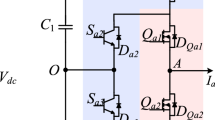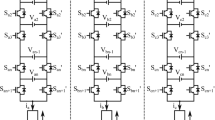Abstract
Random Pulse Width modulation (RPWM) technique is being used presently for producing gate pulses for power electronic circuits such as rectifiers, inverters, and choppers. But in recent times, Direct-Sequence Slow-Frequency Hopping (DS-SFH) Hybrid Spread-Spectrum modulation technique has been employed in military communication systems since it combines the advantages of two different modulation techniques, namely Direct Spread Spectrum Modulation and Frequency Hopping Spread Spectrum Modulation. This hybrid technique is now proposed for the first time, for the suppression of EMI and improvement of power quality in three-phase grid-connected bidirectional Voltage Source Converters. This digital modulation technique is implemented through a compact low-cost SPARTAN Field Programmable Gate Array by developing a suitable VHDL coding for producing the required switching pulses for the converter. A comparative analysis is also presented between the proposed DS-SFH hybrid modulation and the RPWM. It is shown that the implementation of DS-SFH results in reduced EMI, decreased Total Harmonic Distortion, and power factor is also improved significantly.









source voltage and source current waveforms obtained using a RPWM and b DS-SFHSS hybrid modulation technique during rectifier operation of the VSC




source voltage and source current waveforms obtained using RPWM technique during inverter operation of the VSC

source voltage and source current waveforms obtained using DS-SFH hybrid modulation technique during inverter operation of the VSC


Similar content being viewed by others
References
Singh M, Khadkikar V, Chandra A, Varma RK (2011) Grid interconnection of renewable energy sources at the distribution level with power quality improvement features. IEEE Trans Power Delivery 26(1):307–315
C. A. C. Cavaliere, E. H. Watanabe, and M. Aredes, Multi-pulse STATCOM operation under unbalanced voltages, Proceedings of IEEE Power Engineering Society Winter Meeting, 2002, pp 567–572.
Nascimento CF, Watanabe EH, Diene O, Dietrich AB, Goedtel A, Gyselinck JJC, Dias RFS (2017) Analysis of non characteristic harmonics generated by voltage-source converters operating under unbalanced voltage. IEEE Trans Power Delivery 32(2):951–961
Blasko V, Kaura V (1997) A new mathematical model and control of a three-phase ac-dc voltage source converter. IEEE Trans Power Electron 12(1):116–123
Moon J-W, Park J-W, Kang D-W, Kim J-M (2015) A control method of HVDC-modular multilevel converter based on arm current under the unbalanced voltage condition. IEEE Trans Power Delivery 30(2):529–536
Rodrguez JR, Dixion JW, Espinoza JR, Pontt J, Lezana P (2005) PWM regenative rectifiers: state of the art. IEEE Trans Industr Electron 52(1):5–22
Azzidin M.Razal and M. A. Rahman, (2011) Performance Analysis of Three-Phase PWM Rectifier using direct power control, IEEE International Electric Machines and Drives Conference (IEMDC), pp 1603–1608,
Wan C, Huang M, Tse CK, Wong S-C, Ruan X (2013) Nonlinear behavior and instability in a three-phase boost rectifier connected to a non ideal power grid with an interacting load. IEEE Trans Power Electron 28(7):3255–3264
Chittora P, Singh A, Singh M (2018) Chebyshev functional expansion based artificial neural network controller for shunt compensation. IEEE Trans Industr Inf 14(9):3792–3800
Levron Y, Kim H, Erickson RW (2014) Design of EMI filters having low harmonic distortion in high-power-factor converters. IEEE Trans Power Electron 29(7):3403–3413
Kumar AK, Giri SR, Arya RM, Chitti Babu B (2018) Power quality improvement in stand-alone SEIG-based distributed generation system using Lorentzian norm adaptive filter. IEEE Trans Ind Appl 54(5):5256–5266
Tse KK, Chung HS-H, Ron Hui SY, So HC (2002) A comparative study of carrier-frequency modulation techniques for conducted EMI suppression in PWM converters. IEEE Trans Ind Electron 49(3):618–627
Cui K, Adrian V, Gwee B-H, Chang JS (2018) A noise-shaped randomized modulation for switched-mode DC-DC converters. IEEE Trans Circuits Syst-I 62(1):394–405
Bendicks A, Frei S, Hees N, Wiegand M (2018) Systematic reduction of peak and average emissions of power electronic converters by the application of spread spectrum. IEEE Trans Electromagn Compat 60(5):1571–1580
Z. Lin, J. Du, J. Wu, and X. He, (2015) Novel communication method between power converters for DC micro-grid applications, In Proceedings of IEEE 1st International Conference on DC Microgrids, pp 92–96.
R. Wang, J. Du, S. Hu, J. Wu, and X. He, (2014) An embedded power line communication technique for DC-DC distributed power system based on the switching ripple, In Proceedings of IEEE 1st International Conference on Electronics Application Conference Expo., pp 811–815.
Lim Y, Wi S, Kim J, Jung Y (2010) A pseudorandom carrier modulation scheme. IEEE Trans Power Electron 25(4):797–805
A. Rajalakshmi and A. Kavitha, (2018) Implementation of Low-Cost FPGA Based Digital Modulation Techniques for the Suppression of EMI and Improvement of Power Factor for Three-Phase Grid Connected P-V Inverters, IEEE International Conference on Power Electronics, Drives and Energy Systems (PEDES), December .
Rajalakshmi A, Kavitha A (2021) Suppression of EMI using cost-effective FPGA-based digital communication modulation techniques in power converters. IETE J Res. https://doi.org/10.1080/03772063.2021.1911689,April
M. Paramasivan, M. M. Paulraj, S. Balasubramanian, (2017) Assorted carrier-variable frequency-random PWM scheme for voltage source inverter, IET Power Electronics
Lezynski P (2018) Random modulation in inverters with respect to electromagnetic compatibility and power quality. IEEE Trans J Emerg Sel Topics Power Electron 6(2):782–790
Smolenski R, Bojarski J, Kempski A, Lezynski P (2014) Time-domain-based assessment of data transmission error probability in smart grids with electromagnetic interference. IEEE Trans Industr Electron 61(4):1882–1890
Lezynski P, Smolenski R, Loschi H, Thomas D, Moonen N (2020) A novel method for EMI evaluation in random modulated power electronic converters. Meas, Sci Direct 151:107098–107105
Stankovi’C AM, Verghese GC, Perreault DJ (1995) Analysis and synthesis of randomized modulation schemes for power converters. IEEE Trans Power Electron 10(6):680–693
Mohammad AR Khan and Dingrong Shao, (2006) System Performance Analysis of Synchronous Hybrid Direct Sequence-Slow Frequency Hopping Spread Spectrum Multiple Access Communications System Using Support Vector Machines, IEEE International Conference on Computer Systems and Applications, pp 398–401.
Mohammed M. Olama, Xiao Ma, Teja P. Kuruganti, Stephen F. Smith and Seddik M. Djouadi, (2011) Hybrid DS/FFH Spread-Spectrum: A Robust, Secure Transmission Technique for Communication in Harsh Environments, Military Communications Conference, pp 2136–2141.
Hossein Chahrour, Sreeraman Rajan, Richard Dansereau and Bhashyam Balaji, “Hybrid spread spectrum orthogonal waveforms for MIMO radar”, IEEE Radar Conference, 2018, pp. 1010–1014.
R. L. Peterson, R. E. Ziemer and D. E. Borth, (1995) Introduction to Spread Spectrum Communications, Prentice Hall, Upper Saddle River, NJ 07458.
Acknowledgments
The authors would like to thank “SAMEER–The Center for Electro-Magnetics”, Chennai, Tamil Nadu, India for their laboratory support in taking Experimental EMI spectrums of three-phase VSC with various modulation techniques
Author information
Authors and Affiliations
Corresponding author
Additional information
Publisher's Note
Springer Nature remains neutral with regard to jurisdictional claims in published maps and institutional affiliations.
Rights and permissions
About this article
Cite this article
Alavanthan, R., Kavitha, A. Digital implementation of DS-SFH hybrid spread-spectrum modulation technique in three-phase voltage-source converter. Electr Eng 104, 1413–1423 (2022). https://doi.org/10.1007/s00202-021-01388-1
Received:
Accepted:
Published:
Issue Date:
DOI: https://doi.org/10.1007/s00202-021-01388-1




